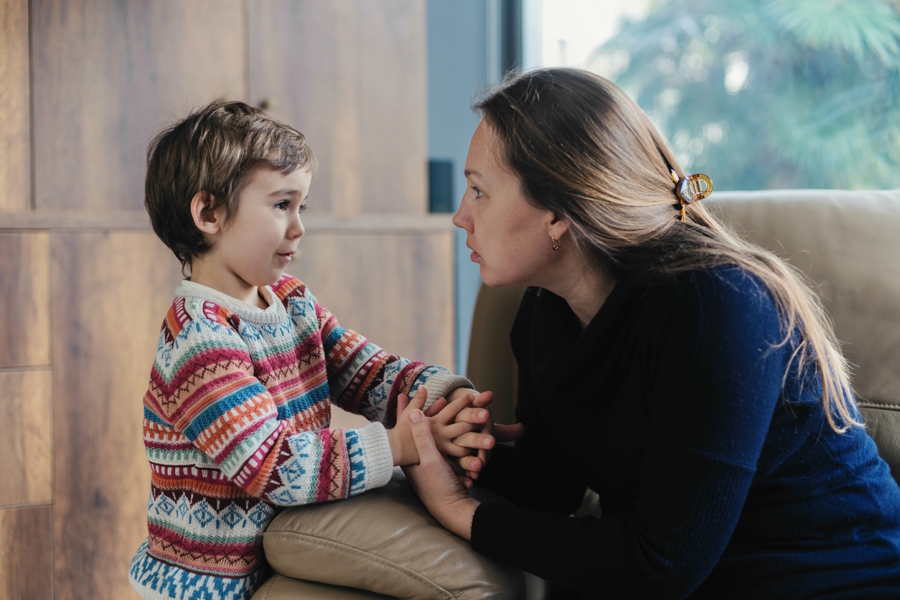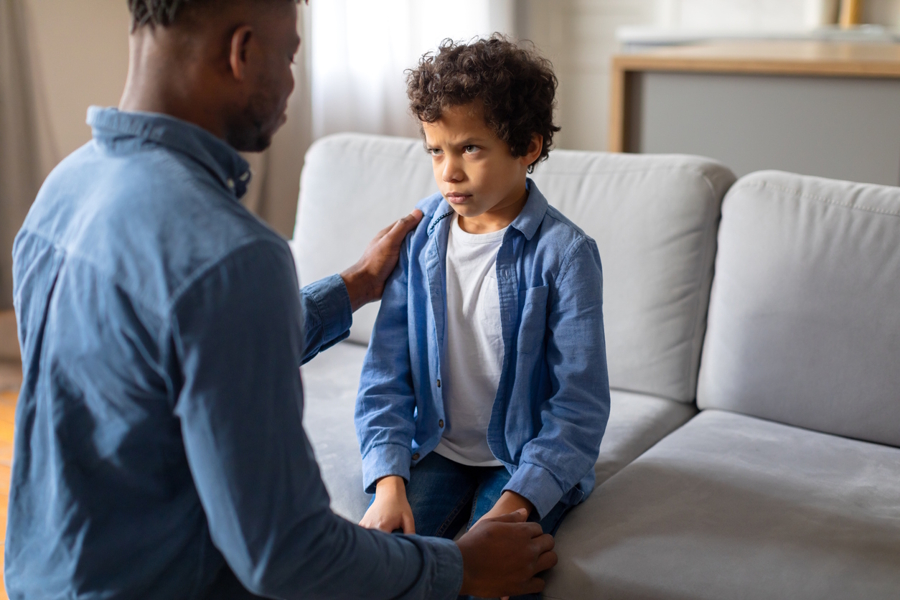
Photo:
iStock
Editor’s note: This article was originally published on Aha! Parenting (now called “Peaceful Parent, Happy Kids”) and is reprinted here with permission.
“What did you do in school today?”
“Nothing.”
Parents often ask what they can say to get their child talking. The secret isn’t about what you say. It’s about how you listen.
The most important skill in talking with anyone, including children, is listening. Not answering, not teaching, not lecturing, not fixing things or offering solutions. Not only do your kids not want that from you, but it would get in the way of them coming up with their own solutions. What your child needs from you is your full attention and empathy. That’s what deep listening is. Here’s how to become a brilliant listener.
1. Pay full attention.
This is your time to listen to your child. It’s a gift to both of you. The shopping list and that problem at the office can wait. Your child knows when you’re really listening. They may not show it, but it breaks their heart when you pretend to and don’t. Turn off your cell phone. Really. They will remember for the rest of their life that you turned off the cell phone just to listen to them.
2. Use conversation openers rather than conversation closers.
Conversation openers acknowledge and reflect feelings without judgment or suggestion, rather than shutting down the feelings. They also usually work better than direct questions to help your child feel comfortable opening up to you. Questions put the other person on the spot and can cause defensiveness, especially when they begin with “why.”
Use conversation openers:
- “You sure sound angry at your brother ...”
- “You seem worried about the field trip today ...”
Avoid conversation closers:
- “You just have to make the effort to get along with your brother!”
- “Don’t be such a baby about the field trip — of course you’re going!”
Avoid asking questions:
- “Why are you so angry at your brother?”
- “Why don’t you want to go on the field trip?”
3. Use words that validate your child’s experience.
You don’t want to say much, just enough to create a sense of safety. Use phrases such as:
- “Oh, no!”
- “No wonder you’re upset.”
- “Nothing seems to be going right for you today.”
- “I’m so sorry I wasn’t there to help.”
- “That must have been so embarrassing [upsetting, frustrating, scary, annoying]!”
- “That would have hurt my feelings, too.”

4. Empathize instead of probe.
“Tell me how you feel” is not an expression of empathy. Empathy is mirroring whatever your child is already showing you.
Saying “You seem sad” or “You’re very quiet tonight,” followed by a warm smile, will encourage your child to open up more than badgering them with questions.
5. Don’t put your child on the spot.
Kids often open up more when we aren’t looking directly at them. Your child may feel more comfortable talking while riding in the car, doing dishes together or walking down the street. Sometimes when we turn the lights out at night, kids pour out their souls to us in the dark.
6. Don’t start by trying to change the feeling or cheer them up.
I promise you, empathizing with the bad feeling is the fastest way to help it dissipate. Arguing a child out of a bad feeling just invalidates it, or pushes the feeling under, only to resurface later. That doesn’t mean you magnify or wallow in the negative feeling, just that you acknowledge it and honor your child’s experience. Once they have a chance to notice, accept and maybe express the feeling, they’ll feel ready for “cheering up” in the sense of a change of scenery and topic.

7. Don’t start solving the problem.
The point is to let your child get past the upset so that they can begin to think about solutions on their own, not to solve it for them. When your child expresses feelings about something, you’ll want to listen and acknowledge, rather than jumping in with solutions. That means you’ll have to manage your own anxiety about the issue.
8. Close your mouth.
You may have to put your hand over your mouth. There are teachable moments, but kids learn most from the opportunity to hear themselves talk and come to their own conclusions. If you give in to the temptation to lecture, your child will clam up. If you want to let your child know you’re listening, make short sounds like “Mmm ... Huh ... Wow!”
9. Match your reaction with their mood.
Your third grader feeling a bit downcast because his team lost the soccer game doesn’t merit a reaction from you as if someone has died. Conversely, mechanically parroting “It can be hard when your boyfriend splits up with you” is likely to provoke hysterical rage in your 14-year-old. The sweet spot here is to empathize so your child knows you understand what they are feeling, but also to communicate your wordless confidence that this, too, shall pass, and someday life will be good again.

10. Keep the conversation safe for your child by managing your own emotions.
When your child shares something with you that makes you anxious, use your pause button to: Stop, drop your anxiety and breathe. Your child needs your help at this moment, not a reprimand. So, for instance, if your child comes home and yells, “I hate that teacher! She yelled at me in front of everyone!” you might well want to respond: “What did you do to make her yell?” or “Kyle, don’t say you hate people!”
But what your child needs to hear is: “Wow! That must have been so embarrassing. No wonder you feel so angry at her!”
If you start feeling responsible (“I could have prevented this!”) or terrified (“I can’t believe this is happening to my child!”), get a grip and put your feelings aside. This isn’t about you right now, and your upset won’t help. You can process your emotions and reactions later. What’s most important is helping your child work through these difficult feelings and possibly come up with a plan of action that works for them.
11. Remember that all your child’s behavior is communication.
Even children who don’t say much want to connect with you. Accept it on their terms. I love this story from Lawrence Cohen, author of “Playful Parenting”:
“I try to take a broad view of what counts as a connection — it isn’t always a deep conversation. It might be a handshake, a hug, a long look in each other’s eyes, a high-five. It might be, as with a young boy named Pete, having his action figure shake hands with my action figure. After Pete did this, I pointed out to his mom, who had described him as unable to connect, how creative he actually was in making contact. He couldn’t handle too much emotional intensity, but he found a way to shake hands with me his way — a playful way.
She said wistfully, ‘You mean he isn’t going to sit and tell me every detail of his day and every nuance of his feelings?’ Sorry. Happily, she was able to start recognizing that Pete’s ways of interacting — like pillow fights and bumping his head into her side — are just as meaningful and full of connection as a deep conversation.”
12. Help your child process emotions with your empathy.
Think of your empathy as a mirror you hold up to your child. Your acknowledgment and acceptance of what they are feeling — even those more disturbing emotions like jealousy and anger — help them to accept their own feelings, which is what allows those uncomfortable feelings to resolve. Most of the time, when kids (and adults) feel that their emotions are understood and accepted, the feelings lose their charge and begin to dissipate. We don’t have to act on those feelings, or even to like them, merely to acknowledge their presence.
Repressed feelings, on the other hand, don’t fade away, as feelings do when they’ve been acknowledged. Repressed feelings are trapped and looking for a way out. Because they aren’t under conscious control, they pop out in unmodulated ways, such as when a preschooler socks her sister, a 7-year-old has nightmares, or an 11-year-old develops a nervous tic.
Accepting feelings and reflecting them does not mean you agree with them or endorse them. You’re showing your child that you understand — nothing more and nothing less. And if you’ve ever felt understood, you know just how great a gift this is.
Editor’s note: This article was originally published a few years ago and was most recently updated on Aug. 25, 2025, by ParentMap’s associate editor, Kari Hanson. New resources were added, and all information was fact-checked.











